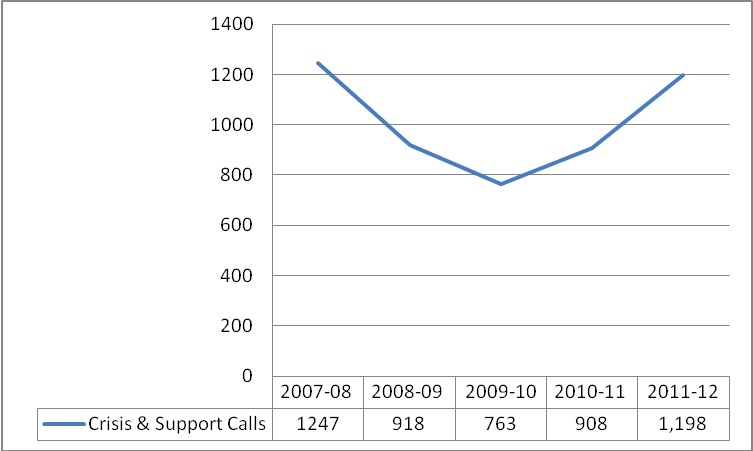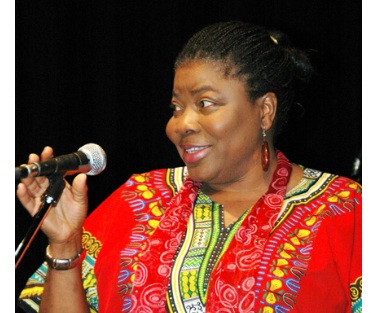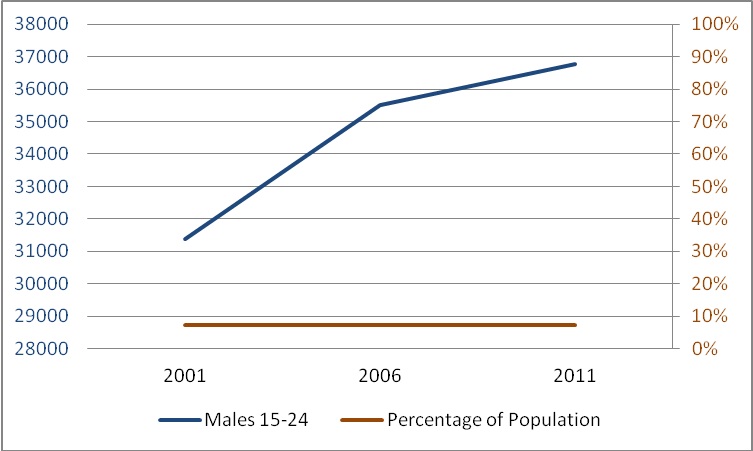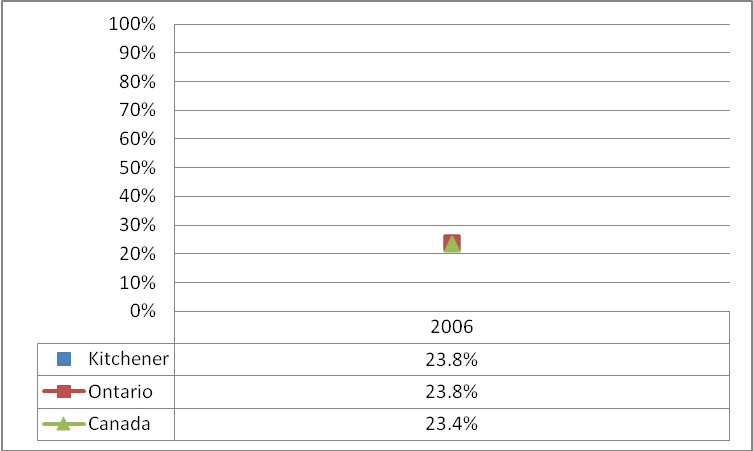Posts Tagged ‘youth’
Posted on: October 30th, 2013 by Waterloo Region Crime Prevention Council
Only one in eight sexual assaults in Canada is reported to police. The Sexual Assault Support Centre of Waterloo Region calls for service provides an additional data point to examine sexual assault rates in Waterloo Region. However, this number should be viewed with caution as it fluctuates based on promotion of the crisis line and provides only total number of calls.
The Statistics

Data Source: Sexual Assault Support Centre of Waterloo Region, Annual Report
Story Behind the Numbers
The Sexual Assault Support Centre of Waterloo Region calls for service have varied considerably since 2007. In the past year there has not been a noticeable increase in the number of calls to the crisis line. In 2012 there was no wait list for men but the wait list for counselling services for women reached an all time high of 40 despite an additional part time counsellor and reducing the number of sessions for some clients. This decrease in counselling availability is creating hardships for victims and may be one reason behind the increase in calls to the crisis line rather than indicative of an increase in sexual assaults.
Read the Community Response:
Posted on: October 15th, 2013 by Smart on Crime
Surprise!! Surprise!! “Length of involvement in schooling significantly impacts participation in criminal activity”, reports the recently released Snapshot on Crime: Root Causes of Crime in Waterloo Region. It is good to have the statistical evidence to corroborate what we already know as parents, teachers, and concerned citizens.
To reframe, length of involvement in schooling increases positive life outcomes for youth. High school graduation and access to post secondary education enhances socioeconomic status in adulthood regardless of growing up in a low income family, parents’ level of education or single parent household. Good news. Although, being born poor sucks, it is not a life sentence. Education however is a big deal and exclusion from it puts you firmly on the school to jail pipeline. Education is the great leveler only if you have it, a child denied this basic human right is hurt for life and community safety is impacted. Access to post secondary education reduces the likelihood of adult criminality, increases employability, ability to stay employed and overall socio economic status. Access to education is a matter of equity and social justice, therefore addressing systemic exclusion and disenfranchisement is crucial.
This is nothing new. The Ontario Royal Commission on Learning and the Review of the Roots of Youth Violence report all decried non inclusive curriculum and recommended schools that reflect minorities and policy changes to address lack of engagement and under achievement of young males, black males, in particular. If black boys face more exclusion from the school system, youth who drop out of school are at higher risk for criminality. Black males are overrepresented in the criminal justice system; it then becomes imperative to challenge our beliefs about black boys being inherently criminal. Being young is a not a bad thing. I have yet to meet any person who was never young once. Being a male child is not bad either and there are communities where people go to any length just to have a male child. Being black is no disaster despite the media characterization of Black masculinity. But still, black males are more often the targets of physical aggression, racism, criminality and criminal victimization.
The African community always knew this. Ten years ago, we initiated an after school homework support program to promote school retention, graduation, equitable access and participation. The homework club provides a safe space where any minority child can feel at home to receive help right where they are at and develop the confidence that facilitates integration into the school system. Our neighbors in Toronto successfully advocated for Africentric schools and now have three, amid fierce debates on both sides. I do not intend to spark debates about segregation or integration. Both are not mutually exclusive.
Through our homework program, we work to mitigate the gaps in the mainstream schools. We provide culturally relevant books, resources and instructional materials that honor African and indigenous orality. We connect youth with strong black role models through career talks, job shadow and motivational talks. We immerse our volunteers, white and black, in the culture and life of the youth. Many volunteers come in wanting to help the kids, but they tell us when they leave (some never leave) that they are the ones helped significantly. Many of them want to be teachers and we gladly provide them with reference letters to get into teachers college. We also organize a parent forum to encourage parents to be their child’s best advocate, to understand the assumptions behind the streaming of students that can result in some youth not having the courses required for post secondary education which hinders their ability to maximize their potential and can permanently alter their life trajectories.
Waterloo region is now the 7th top destination for new immigrants and refugees. We cannot reverse the inflow of immigrants as immigration is Canada’s lifeline in the absence of a replacement population. We could admit only people who are not 15-24, male or black but, 20-somethings tend to settle down and have cute little babies, who soon become teenagers. What if we as a community ensured teachers are trained to recognize the world views and assumptions underlying the fear of big tall black boy children? What if teachers, police and other service providers re-examined our social construction of the black male child? Are there things Waterloo Region can learn from Toronto’s Africentric schools about how to adapt and integrate African, indigenous epistemology and pedagogical practices into mainstream schools so that we can better engage young black men? Opponents of Africentric schools describe them as temporary, not cost effective solutions and appeal to our Canadian ideals of cohesion and multiculturalism. I do not agree with either segregation or integration but cohesion and multiculturalism are myths if they exclude some and attempt to promote assimilation under the guise of integration.
Our homework club struggles for lack of funds but the reason it continues year after year is because the children keep coming back for the acceptance, respect, honor and understanding they receive there.

Funke Oba
Author: Funke Oba is the immediate past president of the African Canadian Association of Waterloo Region & Area. Funke teaches social work, is a diversity trainer/consultant and community based researcher with a focus on social justice, equity and social construction of complex phenomena.
Find more community responses from colleague’s in Waterloo Region who also work with young men:
Posted on: October 10th, 2013 by Smart on Crime
The Snapshot in Time: Root Causes of Crime in Waterloo region data on Young Males 15 – 24, by itself, is good information to have but I don’t think that an increase in the population of males aged 15-24 is any reason for alarm. The data clearly shows that the rise in the number of males aged 15-24 across the Region, as a percentage of the population, is holding steady at 7.2% to 7.4%. We also know that the vast majority of youth crime is being committed by a small number of young offenders. With this information, it gives us sense of size and scope youth male crime/victimization. As a community, we should be taking a strategic/focused approach, first to determine what the root causes of crime are as it relates to this cohort. Secondly, what are some of the best/promising practises that can be done prevent young males from being involved in crime and being victims of crime in the first place.
inREACH, a youth street gang prevention project, is an initiative that is designed to work with young men and women who are involved or at risk of being involved with gangs. inREACH is comprised of two program phases, Community Treatment & Community Mobilization. The Community Treatment phase provides 1-on-1 support in areas of mental health, addictions, employment and overall case management. 94.2% of the participants in the Treatment phase are male with the average age being 18.7 years old, with risk factors such as gang involvement, severe addictions, criminal justice involvement and living/lived in care, it is clear that inREACH is a program that has found away to connect with some of the most at risk male youth in our community. The Community Mobilization phase, happens in four communities through out the region and is focused on prevention. Youth Workers engage youth in these communities by finding out what there strengths/interests are, working with the youth to develop the programs and lastly, having the youth play a key role in the delivery of these programs and having a say in any key decisions about the programs. inREACH has managed to be successful for several reasons. inREACH a multi-disciplinary project, that provides client centred, wrap-around supports to young people that we see as assets to our community and having more then just deficits. inREACH is a collaborative project and all of our community partners are fully engaged in working to address the issue of youth gangs in our community.
There is a lot more that can and should be done. I think that Federal, Provincial , Municipal governments and funding organizations should be focused and work collaboratively to support and enhance all of the work that is being done front line to address the issue of youth gangs, male youth violence & victimization. The majority of inREACH program participants were male, from single parent homes, unemployed and already involved with the criminal justice system. If we use a prevention lens, we know that these youth didn’t just wake up one day with all of these risk factors. They have lived and been exposed to risks most of their young life, so participation in a gang is just the symptom of deeper more complex issues. We need programs that aren’t cookie cutter and pre packaged, we need to develop, support and enhance programs that take a holistic long term approach to supporting our most at risk youth. At the end of the day, they are all of our youth and we have a collective responsibility to ensure that they stay safe, not become criminally involved and are also supported so they can become potential that is fully realized.
Author: Rohan Thompson is the Project Manager for inREACH and staff of the Waterloo Region Crime Prevention Council. inREACH is a collaborative, multi-disciplinary program designed to intervene/prevent gang involved or gang vulnerable youth from being involved in gang activity or exiting their gang. Rohan has been involved in working with at-risk youth for over 15 years. He is an avid football fan and is a proud supporter of Wilfrid Laurier Football.
Find more community responses from colleague’s in Waterloo Region who also work with young men:
Posted on: October 8th, 2013 by Waterloo Region Crime Prevention Council
Young males commit most violent crimes in Canada and they are at a higher risk of being a victim of crime. Young males are more likely than other age and gender cohorts to be involved in petty crime such as vandalism and graffiti. As such, the number of males aged 15 to 24 in a community is likely to have an impact on the crime rate. The chart below measures the absolute number of males 15 to 24 living in the Waterloo Region and the percentage of the overall population made up of males 15 to 24.
The Statistics

Date Source: Statistics Canada, Census (Released Every Five Years)
The Story Behind the Numbers
The number of males in Waterloo Region, aged 15 to 24, is slowly increasing. However, this increase is currently similar to the increase in the overall population in Waterloo Region. Therefore the percentage of the male population 15 to 24 is remaining steady at between 7.2% and 7.4%.
Read the Community Responses:
Posted on: October 8th, 2013 by Smart on Crime
That was my initial reaction when I read the report, “Snapshot in Time: The Root causes of Crime in Waterloo Region”, and especially the information related to Males 15-24 and the following page that talks about youth unemployment and the fact that those things combined with high levels of alcohol consumption, “it is believed to cause an increase in the homicide rate”. Sometimes it just seems that research doesn’t reveal anything in the way of new information but only serves to confirm what have been long held beliefs by members of our community. It doesn’t make the information any less useful to us and in fact it is important information to guide and direct actions we can take to address these specific issues related to the criminal activities of males 15-24 in our community.
Ray of Hope operates Secure and Open custody facilities on behalf of the Province of Ontario for young men aged 13-17 and in the course of any given year we will serve a few hundred young men. Some of them may spend most of their teenage years returning to our care because of their ongoing conflict with the law and as the report suggests conflict with their peers. For many they have not learned the social skills required to manage their anger in a socially acceptable manner. Unlike most adults who learn constructive ways to deal with conflict, or can afford to have lawyers argue for them, young men tend to be impulsive and find the quickest and easiest way to deal with someone they are having trouble with, which generally relates to some type of punch to the face and escalating violence.
It also comes as no surprise that alcohol or drug use may also contribute to criminal behaviour. Ray of Hope also operates a variety of Youth Addiction Treatment programs in the community and there are a number of similarities between the youth we serve in these programs and the youth engaged in our justice programs. The majority of youth entering our addictions treatment programs already have some type of probation orders from the court system related to previous behaviour, but they have not gone far enough to have landed in custody. The majority of youth in our custody programs have substance abuse problems with drugs or alcohol that are related to their crime. For some, they were involved in robberies or break and enter crimes to fund their drug habit, while others committed their crimes while intoxicated or high.
I don’t think that anything I have stated should come as a shock to anyone reading this blog. It is kind of how life is in any community and it has been this way for years. The question we have to ask ourselves is, “can we do anything to change this”? In their report, “Review of the Roots of Youth Violence (2008)”, The Honourable Roy McMurtry and Dr. Alvin Curling identified the following as contributing factors to youth violence:
- Poverty,
- Racism,
- Community Design,
- Education System,
- Family Issues,
- Health,
- Lack of a Youth Voice,
- Lack of Economic Opportunity, and
- Issues in the Justice System
Even without delving into any of the details of the report it is evident that the issue is extremely complex and that no single simple solution can possibly resolve this situation for our community. As a single issue, something like poverty is a huge challenge for our community and seems to be constantly in the news. But there seems to be little political will to really address the issue and find the resources it will take to minimize the impact of poverty let alone eliminate it. The challenges of system change seem to be too overwhelming and yet if we can bring about some systemic changes the impact could be transformative.
But maybe more can be accomplished by focusing on individuals. Over the past few years the Ministry of Children and Youth Services, Youth Justice Services has introduced a concept entitled, “Relationship Custody” to both direct run and transfer payment agencies. The idea behind this concept is that staff are not to be primarily concerned with guarding youth in our facilities but with building relationships with them and trying to encourage them in making better choices for their lives in the future. I believe that Ray of Hope has operated with this type of philosophy from its very beginning and we are always looking for ways to connect with youth and provide them with the support they need to keep them from reoffending.
At a recent staff meeting one of our staff shared about a young man who had spent some time in one of our custody programs in his early teens. He was still struggling with a number of things so a friend suggested he connect with one of our reintegration staff. After meeting with this youth and exploring his life situation, the youth agreed to enter one of our addiction treatment programs. After successfully working through this program he has now enrolled in our Youth Employment program where he is gaining specific life skills and job skills to help him take control of his future. We may not have transformed the system, but this one young man’s life is being transformed.
The challenge is to try and work at both the system and with the individual and then maybe at sometime in the future the percentage of young males 15-24 in our community may prove to be an indicator of a positive healthy community rather than indicator of violent crime.
 Author: Harry Whyte
Author: Harry Whyte
For the past 5 years Harry Whyte has served as the CEO of Ray of Hope Inc, a local agency that provides support to youth in the areas of Justice, Employment and Addictions, along with the Ray of Hope Community Centre that provides support to people impacted by poverty. Harry and his wife Lois were also the parents of 4 boys, now in their late 20’s and 30’s and so has some firsthand experiences with the challenges faced by young men and their families.
Find more community responses from colleague’s in Waterloo Region who also work with young men:
Posted on: September 17th, 2013 by Waterloo Region Crime Prevention Council
The length of involvement in schooling significantly impacts participation in criminal activity and the probability of incarceration. The table below tracks the percentage of residents in the Kitchener-Cambridge-Waterloo Census Metropolitan Area that do not have a high school diploma.
Data Source: Statistics Canada, Census (Released every five years)
Story Behind the Numbers
In 2006, 23.8% of residents in the Kitchener-Cambridge-Waterloo CMA did not have a high school diploma. This is the exact same as the Ontario provincial average and slightly above the Canada average of 23.4%. However, when the results are examined for individuals under the age of 35, the Waterloo Region has more residents without a high school diploma than the Provincial average. This is significant because individuals under the age of 35 are at the highest risk of participating in criminal activity.
Read the Community Responses
Posted on: September 17th, 2013 by Smart on Crime
It is no surprise that the length of involvement in schooling significantly impacts participation in criminal activity and the probability of incarceration, as found in Snapshot in Time: Root Causes of Crime in Waterloo Region. In fact, this has been well-known in the education sector for many years – which explains the great lengths to which school boards go in mitigating against this problem.
As part of the Student Success Learning to 18 Strategy — through the Re-engagement (12 & 12+) Initiative – school boards contact students who have either left school or have not been attending to re-engage them in their studies to complete their Ontario Secondary School Diploma (OSSD). Funding is provided to the boards to support programs for these students once they return and in Waterloo Region’s Catholic Schools we dedicate a significant amount of staff time to, first, actually locating the whereabouts of these students and then helping them complete their required volunteer hours and/or registered them at our St. Louis Adult Learning & Continuing Education Centres or their home secondary school to accumulate credits toward the OSSD.
The tracking of all of our in-risk students (Grade 9 to those that have left our system without an OSSD) is reported to the Ministry of Education along with other student success tracking data through “Taking Stock” reports. These reports outline the following:
- how many students our schools are tracking that are in-risk;
- are these students attached to a caring adult;
- was their timetable individualized;
- are they getting advice on pathways planning;
- has a strengths profile been created for the student.
Our own internal tracking for students who have left our system without an OSSD looks at:
- number of students contacted;
- did they register for courses, how many;
- how many credits did they accumulate.
In addition to the above some key initiatives are in place to meet the needs of all of our students on their way to successful completion of the OSSD.
- Specialist High Skills Majors allow students to focus on a future career through a bundle of classroom courses, workplace experiences and sector certifications
- Expansion of Cooperative Education allows students to count this hands-on learning towards two compulsory high school credits
- E-Learning provides students with online courses and allows teachers to share resources across the province
- Dual Credits count toward a student’s high school diploma as well as a college certificate, diploma or apprenticeship certification
- Credit rescue programs intervene prior to a student experiencing failure in a course
- Credit recovery programs allow students who have failed a course to only repeat expectations where they have been unsuccessful rather than redoing the whole course
- Supervised Alternative Learning programs allow students to work full-time, get mental health supports, volunteer hours and accumulate credits
So…when it comes to playing our role in reducing the number of local residents without a high school diploma you can rest assured Waterloo Region’s Catholic Schools are front and centre in closing the gap.
Author: David DeSantis is the Superintendent of Learning for the Waterloo Catholic District School Board and responsible for Student Success, Secondary Schools, St. Mary’s FOS, Leadership Development and Succession and 21st Century Teaching and Learning.
Posted on: August 26th, 2013 by Smart on Crime
A couple of years ago I was blessed with the opportunity to volunteer with the vulnerable sector here in Kitchener/Waterloo. Specifically, I volunteered with homeless youth under age 25. During this time I was able to get to know many of the youth and listen to their stories. My very first shift I went home an emotional wreck after having a conversation with a young girl not much older than my own daughter.
It wasn’t long before I became acutely aware of the higher incidence of drug use, mental health problems and criminal activity among this population.
Someone said to me one day, ‘they have a choice, we all have choices.’ My reply was ‘sure we all have choices but we have not all been given the same tools to make good choices. How can I compare myself, who grew up with 2 upstanding parents and all the social support a child should need to someone who was sexually abused from the time they could walk or someone who was given their first hit of crack by their own mother at the age of 16.’ Unfortunately many of our homeless population were not raised with good role models or a good set of standards. They once left the hospital as precious, innocent and adorable as any other infant. What they went home to however, is more often than not less than acceptable. Fast forward several years and we find an adult struggling with addiction, mental health issues and homelessness all leading to criminal activity.
Here we find the beginning of a two-way cycle. Those who are homeless have a higher probability of ending up in prison while those being released from prison have a higher likelihood of ending up homeless. Once someone has a criminal record it is very difficult to find a job no matter how hard they try to change their life around. Often the rejection turns them back to crime. The same goes for substance abuse where substance abuse often leads to homelessness and homelessness often leads to substance abuse. Addictions often cause someone to lose their job and housing. Using drugs or alcohol also becomes a way to cope with life on the street.
On the other side we have a society that is often quick to judge and quick to condemn often due to a lack of awareness. People feel uncomfortable with it and try to look the other way. It’s easier to make donations to charities such as to the food bank than to look in the face of a homeless person on the street.
While food banks and shelters do a great job of providing for immediate needs, they are merely band-aid solutions. They treat the immediate problem not the root of the problem. What we need is to create awareness for other fundamental necessities for tackling homelessness and the crime it brings with it.
We need a plan to create awareness of costs of providing stable housing versus the much higher costs of providing services to the homeless. (ie. Institution, shelters, healthcare, and social services) It is difficult for someone without a place to call home to receive and accept the help they need for addiction and mental health. Without this there is difficulty in reducing the crime rate. Those who seek treatment such as rehab often have nowhere else to go but back in the same street or shelter environment, making relapse highly likely. It’s a set-up for failure. When we provide those in need with stable housing we give the opportunity to live with dignity, reduce crime, reduce addiction and give the opportunity for better success. It is a win, win situation. The more people we help get into stable housing the less financial burden on society and less crime in our community. We build a system that encourages social competency. Give respect to gain respect. This is the message we need to get out. We need to put as much effort into creating awareness and fundraising for this as we do when collecting food and socks.
The diagram below shows the connection between homelessness, substance abuse, mental health, crime and unemployment. If we take homelessness out we have a better chance at battling the other problems.

Lets help society to see the person behind the face. Lets take the homeless away from the street environment and give them a place to call home and give them some dignity and a foundation in which to grow.
 Author: Sheri Cartwright
Author: Sheri Cartwright
In the past Sheri has volunteered with homeless youth in Kitchener at ROOF – Reaching Our Outdoor Friends. Currently she volunteers for the KW Youth Basketball Association as volunteer coordinator and coach. She also runs the Community Dialogue website and is involved in community building and creating awareness in hopes of helping to break down barriers and stereotypes to help create a healthier, safer community. She graduated from Health Studies at UW last year and recently started Dynamic Health Promotion.
Find more community responses from colleague’s in Waterloo Region who also work to reduce homelessness:
Posted on: August 21st, 2013 by Smart on Crime
People who are homeless are far more likely to be victims of crime than are people who are housed. One Toronto study determined that 46% of homeless women and 39% of homeless men surveyed had been physically assaulted within the previous year. Homeless youth fared worst of all, with 69% reporting having been attacked. Another study found that sexual assaults against women who are homeless are both more frequent and more violent than those against women who are housed1. Preventing crimes against vulnerable people by supporting them as they move through homelessness to housing is one of the priorities of YWCA Kitchener-Waterloo.
It goes almost without saying that the overarching cause of homelessness is poverty, but not all people who are poor become homeless. Not all people who become homeless stay that way for long. Some of the factors that make it more likely that poor people will become and stay homeless include mental illness, addiction, cognitive or physical disability, family breakdown and social isolation. And social isolation is a much bigger part of the destructive cycle of homelessness than most people realize.
People who are homeless can experience social isolation because they’re separated from their families and communities, because prejudice and fears about homelessness keep others at a distance, and sometimes because their own shame about their circumstances prevents them from reaching out to others. As their social isolation increases, over time their social skills can diminish, and with the erosion of their social skills can come the loss of even more of their already depleted circle of support. The absence of social support causes problems like higher rates of mental health issues and physical illnesses, increased use and abuse of drugs and alcohol, and engagement in risky sexual behaviours. Thus, social isolation doesn’t just worsen the pain of homelessness, it perpetuates and strengths the cycle itself.
Among our other programs, YWCA Kitchener-Waterloo offers emergency and transitional and permanent, affordable housing to women and families and trans individuals who are or have been persistently homeless. We try to build housing and supports that make the people whom we serve know that they are welcome and valued members of our community, because we believe that this knowledge is critical to their mental and physical well-being and to their future housing stability. So that we could better understand and enhance their experiences of social inclusion, over the winter and spring of 2013 we asked the tenants in one of our housing programs to join us over coffee and cookies in some conversations about community.
The women who came together had all been homeless prior to coming to our program. Some had been housed with us for as few as four months, others as many as 24 years. The women told us about the things we do well to foster their sense of belonging and about some things we should do better. And they told us that it was their building’s community feeling – not its bricks and mortar – that made them feel supported and secure. They said that it was having people to turn to in times of sickness or crisis, having people to encourage them to overcome their challenges and reach their goals, to share activities and interests, simply having people to talk to, that made them feel safe. It was, in the words of one woman, ‘knowing other people care’ that made them feel that they finally had a home.
YWCA Kitchener-Waterloo is privileged to have the resources to provide the buildings and the professional, formal supports that some people who are homeless require. But for just about all homeless people, informal social supports can make the experience of homelessness more bearable and much safer. For some people, such supports can be all it takes to break the cycle of homelessness. Share a meal with a diner at St. John’s Kitchen. Play a card game with a guest at an Out of the Cold site. Teach a new skill to a youth at ROOF. Stop and listen to the story of a woman on the street. Give of yourself, emotionally and practically, for just a few minutes or a few hours, to make a critical difference in the mental and physical health, happiness, confidence, stability and safety of a vulnerable person.
1. Centre for Urban and Community Studies, University of Toronto, Research Bulletin #37, September 2007
 Author: Elizabeth Clarke is the Chief Executive Officer of YWCA Kitchener-Waterloo, an multi-service organization that provides emergency, transitional and permanent supportive housing to women, families and trans individuals who are homeless.
Author: Elizabeth Clarke is the Chief Executive Officer of YWCA Kitchener-Waterloo, an multi-service organization that provides emergency, transitional and permanent supportive housing to women, families and trans individuals who are homeless.
Find more community responses from Elizabeth’s colleague’s in Waterloo Region who also work to reduce homelessness:
Posted on: August 21st, 2013 by Smart on Crime
Community members experiencing homelessness in Waterloo Region, as in many other communities, are often looked upon with fear – they experience stigma and exclusion on a daily basis in addition to the other challenges of being without a home – including extreme poverty, hunger, mental illness, addiction, and trauma. A significant part of this stigma has to do with the perception of crime and risk associated with homelessness. Stigma and the perception of risk are very interesting things – I do a lot of community presentations, and when asked to describe the perception of a person experiencing homelessness and their lifestyle, the responses are very telling. I often hear terms like “poor”, “unhealthy”, “vulnerable”, “hungry” etc. I also hear terms like “criminal”, “violent”, and commonly, “nothing-to-lose”. Rarely, I hear “resourceful”, “strong”, and “determined”.
The thing is, we know that if a person experiencing homelessness does commit a crime and is charged, it is most frequently with minor property theft, by-law violations, or substance related charges. Despite the perception of risk and the belief that a person may have nothing to lose, violent crime is not strongly associated with homelessness, and many people experiencing homelessness are actively engaged in supporting their families and the community.
The research on homelessness and crime supports the cause and effect perspective rather than a predisposition to criminal activity – that when any individual has little or no money, food, shelter, or safety and is excluded from the formal economy, that person may turn to quasi-legal sources of income generation (panhandling, squeegeeing, sex trade etc.) or illegal activities (theft, drug dealing) to make money and survive. This does often result in charges, but it doesn’t seem all that surprising given the context, and doesn’t support the perception of risk that surrounds the issue of homelessness.
At Supportive Housing of Waterloo (SHOW), we provide permanent and supportive housing to 33 individuals who have experienced persistent homelessness and barriers to housing. We have seen the results of housing stability and appropriate supports for many of the people who call SHOW home in the form of reduced interactions with police and the justice system, increased personal safety and stability, and improved health through housing and food stability. We, at SHOW, share the concern of our community about the minor property theft, bylaw violations, and substance related offences being committed by individuals experiencing homelessness, and believe that being accepted and engaged in a community, having food stability, support, and an affordable place to live are great ways for us as a community to address this concern.
We are also concerned with the fact that people experiencing homelessness are more likely to be victims of crime than those with homes. As we saw in the Snapshot in Time report, the numbers of people accessing emergency shelters are rising. We know that in addition to that, there are many people unstably or inappropriately housed, couch surfing, moving from short-term residence to short-term residence, and living on the streets unsheltered. From 2011 data we know that wait-lists are long (3,280 households were on the Community Housing Waiting List), vacancy rates are low (1.7% – far below the ideal of 3%), and rental costs are high, especially when compared to minimum wage and social assistance rates (average market rent for a one-bedroom was $751.00 – minimum wage was $10.25, and the monthly shelter allowance for a person on OW was $372.00 and $474.00 for ODSP)1.
That means that a lot of people in our community are particularly vulnerable to crime and victimization due to inappropriate and unaffordable housing and a lack of support. Compared to the housed, people experiencing homelessness have more often been the victims of physical and sexual abuse as children, and victims of family violence and spousal assault as adults. Those without adequate shelter are also more likely than the housed to be victims of violence and, for women, victims of sexual assault. According to an Institute for the Prevention of Crime report on homelessness and victimization, providing housing as well as appropriate social and income supports to end homelessness are the best approaches for addressing crime and victimization associated with homelessness.
At SHOW, we agree, and we look forward to continuing to work with our community to meet the housing, support, and safety needs of all of our neighbours.
1. 2011 data pulled from the HHUG Annual Report Card, 2012.
 Author: Lindsay Klassen holds a BA and MSW as well as a Certificate of Leadership and Management from Wilfrid Laurier University, and is the Program Manager at Supportive Housing of Waterloo (SHOW). SHOW provides housing first and harm reduction support for individuals who have experienced persistent homelessness. Lindsay brings her personal and professional dedication to working with SHOW to provide individuals with the opportunity and supports to find a place to call home.
Author: Lindsay Klassen holds a BA and MSW as well as a Certificate of Leadership and Management from Wilfrid Laurier University, and is the Program Manager at Supportive Housing of Waterloo (SHOW). SHOW provides housing first and harm reduction support for individuals who have experienced persistent homelessness. Lindsay brings her personal and professional dedication to working with SHOW to provide individuals with the opportunity and supports to find a place to call home.
Find more community responses from Lindsay’s colleagues in Waterloo Region who also work to reduce homelessness:




 Author: Harry Whyte
Author: Harry Whyte

 Author: Sheri Cartwright
Author: Sheri Cartwright Author: Elizabeth Clarke is the Chief Executive Officer of YWCA Kitchener-Waterloo, an multi-service organization that provides emergency, transitional and permanent supportive housing to women, families and trans individuals who are homeless.
Author: Elizabeth Clarke is the Chief Executive Officer of YWCA Kitchener-Waterloo, an multi-service organization that provides emergency, transitional and permanent supportive housing to women, families and trans individuals who are homeless. Author: Lindsay Klassen holds a BA and MSW as well as a Certificate of Leadership and Management from Wilfrid Laurier University, and is the Program Manager at Supportive Housing of Waterloo (SHOW). SHOW provides housing first and harm reduction support for individuals who have experienced persistent homelessness. Lindsay brings her personal and professional dedication to working with SHOW to provide individuals with the opportunity and supports to find a place to call home.
Author: Lindsay Klassen holds a BA and MSW as well as a Certificate of Leadership and Management from Wilfrid Laurier University, and is the Program Manager at Supportive Housing of Waterloo (SHOW). SHOW provides housing first and harm reduction support for individuals who have experienced persistent homelessness. Lindsay brings her personal and professional dedication to working with SHOW to provide individuals with the opportunity and supports to find a place to call home.